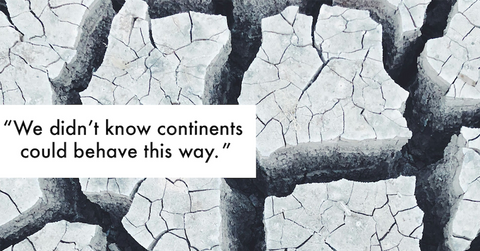
Groundbreaking study reveals a massive country splitting into two
By Megaphone StaffJune 25 2024, Published 6:07 p.m. ET
Rising high above the Earth, the Himalayas are not only stunning but vital to geological research. A 2023 study indicates that the Indian tectonic plate, forming the Himalayas' foundation, might be splitting apart due to a unique geological phenomenon.
The Great Himalayas, with their jagged peaks, encompass hundreds of mountains, including the towering Mount Everest at 29,035 feet. Around 40-50 million years ago, the Indian Plate's collision with the Eurasian Plate caused the Earth's crust to buckle, forming these massive structures. Their similar thickness led them to merge rather than crash, resulting in today's colossal formations.

The Annapurna range of the Himalayas
Stanford geologist Simon L. Klemperer and his team ventured to Bhutan's Himalayas to investigate helium levels in Tibetan springs. Although the region is rich in gold and silver, the unusual helium readings pointed to a possible dormant volcano beneath the surface.
The research explored two theories: the Indian Plate colliding horizontally with the Eurasian Plate, and the Indian Plate dipping underneath, melting into magma and releasing helium. Klemperer's team discovered higher helium levels in southern Tibet than in northern Tibet, concluding that the Indian Plate is splitting into two fragments beneath the Tibetan plateau, a process known as "delamination."

Mardi Himal Base Camp, Lumle, Nepal
Klemperer introduced a third theory, suggesting both processes were occurring at once: the Indian Plate's top was rubbing against the Eurasian Plate, while its bottom was subducting into the mantle. The findings, presented at the December 2023 American Geophysical Union conference, were groundbreaking. “We didn’t know continents could behave this way and that is, for solid earth science, pretty fundamental,” Douwe van Hinsbergen, a geodynamicist from Utrecht University, told Science.
Using isotope instruments, Klemperer measured helium bubbling in mountain springs, collecting samples from roughly 200 springs over 621 miles. They identified a stark boundary where mantle rocks met crust rocks and found three springs where the Indian Plate seemed to peel like banana skins.

Mount Everest, Nepal
Tectonic plates resemble a layered cake, with a dense, thick bottom layer. When plates collide, weaker layers can fracture. Scientists knew plates could peel away like this, mainly in thick continental plates and computer simulations. “This is the first time that … it’s been caught in the act in a downgoing plate,” van Hinsbergen said.
This unstable configuration of tectonic plates threatens the mountain range and indicates potential earthquakes and tremors. While the study provided valuable data, it also highlighted the conflicting forces of nature at work.
This article was written with assistance from artificial intelligence. Megaphone creates content primarily driven by people but aims for full transparency in how our storytelling is produced. To learn more about our policy on artificial intelligence, click here.
